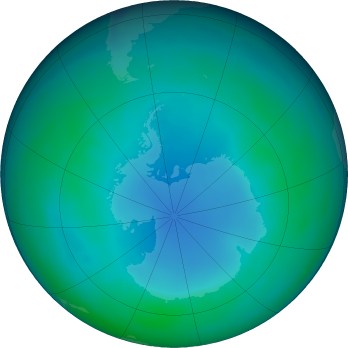View all of the Antarctic Hemisphere daily maps of total ozone for May 2023. Satellite instruments monitor the ozone layer, and we use their data to create the images that depict the amount of ozone.
Click any map image to bring up a new page with a high-resolution map.
Data source
The data for this month are from the OMPS instrument onboard the Suomi NPP satellite.
Missing areas (bad orbits and polar night) are filled using assimilated ozone data. The GEOS FP data are produced by the Goddard Earth Observing System data assimilation system (DAS). The GEOS FP system integrates forefront versions of the GEOS atmospheric general circulation model with advanced data assimilation techniques, using a broad range of satellite observations.
May 2023

The false-color view of the monthly-averaged total ozone over the Antarctic pole. The blue and purple colors are where there is the least ozone, and the yellows and reds are where there is more ozone.
Calendar
A week begins with Sunday. Fainter images are shown in the previous and following months. Missing days are indicated with a plain gray globe.

|

|

|

|

|

|

|
| 30 | 1 | 2 | 3 | 4 | 5 | 6 |

|

|

|

|

|

|

|
| 7 | 8 | 9 | 10 | 11 | 12 | 13 |

|

|

|

|

|

|

|
| 14 | 15 | 16 | 17 | 18 | 19 | 20 |

|

|

|

|

|

|

|
| 21 | 22 | 23 | 24 | 25 | 26 | 27 |

|

|

|

|

|

|

|
| 28 | 29 | 30 | 31 | 1 | 2 | 3 |
Map archives
Monthly averages (1979–current)
Daily
- 1995
- January
- February
- March
- April
- May
- June
- July
- August
- September
- October
- November
- December


